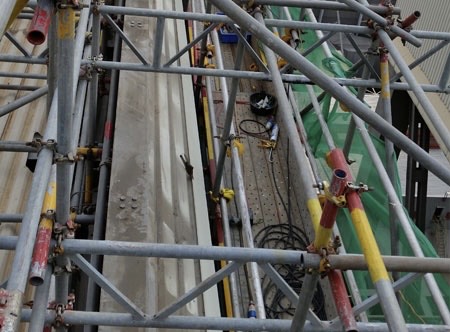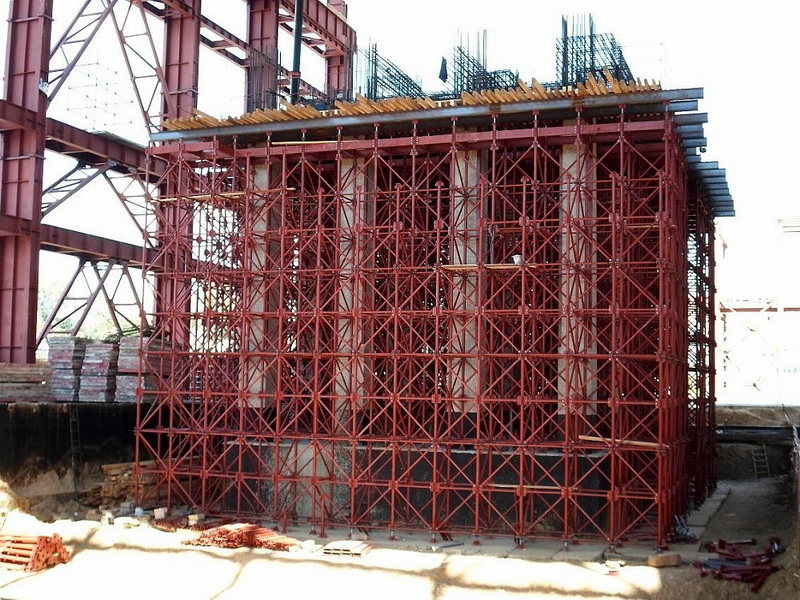Content Menu
● What Is Scaffolding Tube and Coupler?
● Types of Couplers
● What Is Frame Scaffolding?
● Strength and Load Capacity Comparison
>> Load Capacity of Scaffolding Tube and Coupler
>> Load Capacity of Frame Scaffolding
>> Structural Strength and Stability
● Advantages of Scaffolding Tube and Coupler Over Frame Systems
>> 1. Flexibility and Customization
>> 2. Higher Load-Bearing Capacity
>> 3. Durability and Longevity
>> 4. Repair and Replacement
● Advantages of Frame Scaffolding Over Tube and Coupler
>> 1. Speed of Assembly
>> 2. Ease of Use
>> 3. Cost Efficiency for Standard Jobs
● Safety Considerations
>> Tube and Coupler Scaffolding
>> Frame Scaffolding
● Practical Applications and Suitability
● Conclusion
● FAQ
>> 1. How strong is scaffolding tube and coupler compared to frame scaffolding?
>> 2. Can swivel couplers support the same loads as right angle couplers?
>> 3. What materials are scaffolding tubes and couplers made from?
>> 4. How important is proper torque when tightening couplers?
>> 5. Which scaffolding system is better for irregular building shapes?
Scaffolding is an essential component in construction, maintenance, and renovation projects, providing safe access and working platforms at height. Among the various scaffolding systems, scaffolding tube and coupler and frame scaffolding systems are two of the most widely used. A common question arises: How strong is scaffolding tube and coupler compared to frame systems?

What Is Scaffolding Tube and Coupler?
Scaffolding tube and coupler systems, also known as tube and clamp scaffolding, consist of steel tubes connected by various types of couplers (clamps). The tubes are typically 48.3 mm in diameter with wall thicknesses ranging from 3.2 mm to 4.8 mm, made from high-grade steel. Couplers join the tubes at various angles, allowing for highly customizable scaffolding structures.
Types of Couplers
- Right Angle Coupler: Joins two tubes at 90 degrees, commonly used to connect ledgers to standards.
- Swivel Coupler: Allows connection at any angle, providing flexibility for complex scaffolding geometries.
- Putlog Coupler: Connects putlog tubes to ledger tubes, often used in facade scaffolding.
- Sleeve Coupler: Joins two tubes end-to-end to extend length.
What Is Frame Scaffolding?
Frame scaffolding consists of prefabricated welded frames that are connected by cross braces. The frames are usually made from tubular steel or aluminum and come in standard sizes and shapes, making assembly faster and more straightforward than tube and coupler systems.
- Frames typically have integrated ledgers and transoms.
- Cross braces provide lateral stability.
- Platforms rest on horizontal members fixed within the frame.
Strength and Load Capacity Comparison
Load Capacity of Scaffolding Tube and Coupler
- According to technical manuals, right angle couplers have a typical working load limit (WLL) of 6.25 kN (approximately 637 kgf) against slip at a tightening torque of 54 Nm.
- The tubes themselves, usually 48.3 mm diameter with 4 mm wall thickness, have a yield strength around 385 MPa and ultimate tensile strength of about 457 MPa.
- Swivel couplers, while versatile, have similar load capacities but are generally not used for primary load-bearing members due to their rotational flexibility.
- Properly assembled tube and coupler scaffolding can resist both tension and compression loads, making it highly adaptable for complex structures.
Load Capacity of Frame Scaffolding
- Frame scaffolding systems generally have a rated load capacity of around 2 to 4 kN per frame bay, depending on design and manufacturer specifications.
- The welded frames are engineered for rapid assembly and moderate loads but have less flexibility in configuration.
- Frames are often designed to handle uniform loads and are not as adaptable to irregular or non-linear structures.
Structural Strength and Stability
- Tube and coupler scaffolding offers superior strength and stability for irregular or complex shapes because couplers can connect tubes at any angle, allowing for precise bracing and load distribution.
- Frame scaffolding is strong in vertical and horizontal directions but limited in adaptability, which can reduce stability in non-standard configurations.
- The modular nature of tube and coupler scaffolding allows for additional bracing and reinforcement, increasing overall structural integrity.
Advantages of Scaffolding Tube and Coupler Over Frame Systems
1. Flexibility and Customization
- Tube and coupler scaffolding can be assembled in virtually any shape or size, accommodating complex architectural features or uneven terrain.
- Swivel couplers enable connections at any angle, unlike fixed frame scaffolds.
2. Higher Load-Bearing Capacity
- The ability to add diagonal bracing and custom configurations allows tube and coupler scaffolding to support heavier loads.
- Couplers made from drop-forged steel with hot-dip galvanization provide durability and corrosion resistance.
3. Durability and Longevity
- Tubes and couplers are made from high-grade steel with corrosion-resistant finishes, allowing for long service life even in harsh environments.
- Components can be reused multiple times with proper maintenance.
4. Repair and Replacement
- Individual tubes or couplers can be replaced easily if damaged without dismantling large sections.
- Frame scaffolding requires replacing entire frames if damaged, which can be costlier.
Advantages of Frame Scaffolding Over Tube and Coupler
1. Speed of Assembly
- Prefabricated frames allow faster erection and dismantling, saving labor costs on standard projects.
- Ideal for simple, repetitive tasks on flat surfaces.
2. Ease of Use
- Less technical skill required for assembly compared to tube and coupler scaffolding.
- Standardized components simplify training and reduce errors.
3. Cost Efficiency for Standard Jobs
- For straightforward projects, frame scaffolding can be more economical due to lower labor costs and faster setup.

Safety Considerations
Tube and Coupler Scaffolding
- Requires skilled labor for correct assembly to ensure couplers are tightened to the correct torque (typically 54 Nm).
- Regular inspection of couplers and tubes is essential to detect wear, corrosion, or loosening[5].
- Coupler looseness can reduce stiffness and load capacity, especially under cyclic or side loads such as wind.
Frame Scaffolding
- Generally safer for untrained workers due to simpler assembly.
- Limited flexibility means fewer chances of incorrect configurations.
- However, less adaptable to complex sites, which can compromise safety if forced to fit unsuitable conditions.
Practical Applications and Suitability
| Application Type | Best Choice | Reason |
| Complex architectural projects | Tube and coupler scaffolding | Customizable shapes and bracing |
| Standard building facades | Frame scaffolding | Fast setup and cost-effective |
| Industrial plants | Tube and coupler scaffolding | Heavy loads and irregular layouts |
| Short-term rental projects | Frame scaffolding | Quick assembly and dismantling |
| Long-term, large-scale projects | Tube and coupler scaffolding | Durability and flexibility |
Conclusion
Both scaffolding tube and coupler and frame scaffolding systems have their places in construction and maintenance. However, when it comes to strength, adaptability, and load-bearing capacity, tube and coupler scaffolding generally outperforms frame systems. Its modularity, ability to incorporate diagonal bracing, and robust coupler design provide superior structural integrity, especially for complex or heavy-duty projects.
Frame scaffolding offers speed and simplicity, making it suitable for straightforward, repetitive tasks on flat surfaces. Choosing between the two depends on your project's complexity, load requirements, and timeline.
Proper assembly, regular inspection, and adherence to safety standards are critical regardless of the system chosen to ensure a safe and effective scaffolding structure.

FAQ
1. How strong is scaffolding tube and coupler compared to frame scaffolding?
Scaffolding tube and coupler systems are generally stronger and more adaptable due to their customizable connections and ability to incorporate diagonal bracing, with couplers rated for working loads around 6.25 kN.Frame scaffolding is strong but less flexible and typically supports lower uniform loads.
2. Can swivel couplers support the same loads as right angle couplers?
Swivel couplers have similar load capacities but are typically used for bracing and tension splicing rather than primary load-bearing connections due to their rotational flexibility.
3. What materials are scaffolding tubes and couplers made from?
Tubes are usually high-strength steel with diameters of 48.3 mm, and couplers are forged steel with hot-dip galvanization for corrosion resistance.
4. How important is proper torque when tightening couplers?
Very important. Typical tightening torque is 54 Nm. Under-tightening can lead to slippage and reduced load capacity, while over-tightening can damage components.
5. Which scaffolding system is better for irregular building shapes?
Tube and coupler scaffolding is preferred due to its flexibility and ability to connect tubes at any angle with swivel couplers, making it ideal for complex geometries.






















